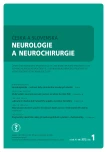Vertebroplasty – Treatment Option for Structurally Insufficient Vertebras
Authors:
Pavel Barsa
Authors place of work:
Neurochirurgické oddělení, Neurocentrum, Krajská nemocnice Liberec a. s.
Published in the journal:
Cesk Slov Neurol N 2012; 75/108(1): 8-17
Category:
Minimonografie
Summary
Percutaneous vertebroplasty is a minimally invasive technique that has been developed to treat pain secondary to vertebral fracture. The technique, originally described in 1987, was used on the basis of the hypothesis that consolidation of fragile and painful vertebra should eliminate pain. Having been first successfully used in the treatment of vertebral hemangiomas, it was subsequently introduced in the treatment of metastatic lesions, osteoporotic compressive fractures, aneurysmatic bone cysts as well as, for example, insufficiency of sacral fractures. The excellent clinical results obtained with percutaneous augmentation of vertebral bodies, together with limited incidence of clinically relevant complications, have resulted in gradual increase in the number of treated patients and wider clinical use of this technique. Optimistic outcome is reported also in open surgical procedures, where vertebroplasty has been implemented in order to increase stability of implants. The aim of the review article is to describe the technique itself, its complications, indications and relevant aspects of the specific patient care.
Key words:
vertebroplasty – vertebral fracture – treatment –
osteoporosis – vertebral hemangioma – secondary bone tumor –
complications
Zdroje
1. Ryška P, Hrubešová J, Málek V, Pavlíková V, Kračmarová R, Řehák S. Perkutánní vertebroplastika a kyfoplastika. Hradec Králové: vydavatelství Olga Čermáková 2010.
2. Klazen CA, Lohle PN, de Vries J, Jansen FH, Tielbeek AV, Blonk MC et al. Vertebroplasty versus conservative treatment in acute osteoporotic vertebral compression fractures (Vertos II): an open-label randomised trial. Lancet 2010; 376(9746): 1085–1092.
3. Cheung G, Chow E, Holden L, Vidmar M, Danjoux C, Yee AJ et al. Percutaneous vertebroplasty in patients with intractable pain from osteoporotic or metastatic fractures: A prospective study using quality-of-life assessment. Can Assoc Radiol J 2006; 57(1): 13–21.
4. Guarnieri G, Ambrosanio G, Vassallo P, Pezzullo MG, Galasso R, Lavanga A et al. Vertebroplasty as treatment of aggressive and symptomatic vertebral hemangiomas: up to 4 years of follow-up. Neuroradiology 2009; 51(7): 471–476.
5. Frey ME, Depalma MJ, Cifu DX, Bhagia SM, Carne W, Daitch JS. Percutaneous sacroplasty for osteoporotic sacral insufficiency fractures: a prospective, multicenter, observational pilot study. Spine J 2008; 8(2): 367–373.
6. McDonald RJ, Trout AT, Gray LA, Dispenzieri A, Thielen KR, Kallmes DF. Percutaneous vertebroplasty for osteolytic metastases and myeloma: effects of the percentage of lesion filling and the leakage of methyl methacrylate at clinical follow-up. AJNR Am J Neuroradiol 2008; 29(4): 642–648.
Štítky
Detská neurológia Neurochirurgia NeurológiaČlánok vyšiel v časopise
Česká a slovenská neurologie a neurochirurgie

2012 Číslo 1
- Metamizol jako analgetikum první volby: kdy, pro koho, jak a proč?
- Fixní kombinace paracetamol/kodein nabízí synergické analgetické účinky
- Antidepresivní efekt kombinovaného analgetika tramadolu s paracetamolem
- Kombinace paracetamolu s kodeinem snižuje pooperační bolest i potřebu záchranné medikace
- CIDP: epidemiológia, klinický obraz a diagnostika v kocke
Najčítanejšie v tomto čísle
- Vertebroplastika – možnost léčby strukturálně narušených obratlů
- Karpální tunel a neurochirurg – zkušenosti po 2 200 operacích
- Kazuistika Guillainova-Barrého syndromu u pacienta s renálním karcinomem
- Klinický standard pro farmakoterapii neuropatické bolesti
